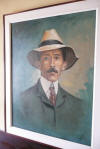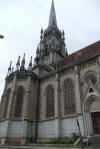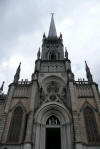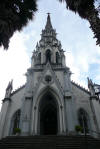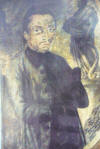Diary/Photo Journal
Week of January 13, 2008 (see page 9 for the
second half of the week)
The start to this week set the tone and pace for the entire week as we were on-the-go from the get-go. We met with Maria Luiza (Gerson's cousin) and her husband, Jacque and headed to their fazenda (farm) outside of Rio de Janeiro. Actually, I should say two fazendas and they own two separate farms about an hour apart.
The main fazenda has their quaint home nestled within the mature landscaping that Jacque designed himself. Jacque has owned the fazenda for over 30 years and he built much of it to his own taste. There is a pool and terrific bar-b-que area along with many kilometers of roads to explore.
    |
The original small homestead and
the house today Enjoying the pool The view out from the dining salon area |
    |
The path to the bar-b-que area Various views across the fazenda |
These fazendas are typical of many of the farms one would see around the major cities. They are usually owned by the city's more wealthy inhabitants and run by on-site "caretakers" or workers. The owners provide free housing with all the utilities, farm vehicles, farm animals, etc. and also pay a salary to the live-in employees. The employees in turn, take care of all the land's needs, the animals and the main home. It is not uncommon to meet families wherein at least one family member is illiterate and unable to even write their own name. As there really is no other work in this modern world for such a person, this arrangement is a good fit. The workers have a home provided for them and they receive some money for their work.
We spent lunch in small nearby town called Silva Jardim and I had probably one of the best meals I have ever had in Brasil (with Brasil's outstanding food, this is a big boast). The town just vibrated with small-town niceness and people were out and about everywhere. At night, the corners of the central park were bustling with people lined up to get a sorvete (ice cream) or other doces (sweets). It was the same at the local pizza place as it seemed that the restaurant was the local gathering place.
The second day out amongst the farms, we visited the second fazenda and it definitely was our favorite. This fazenda does not have a family "home" and is made up of several employee houses and incredible open ranges. The primary caretaker family were warm and friendly and even though the home was small and had concrete floors, there was not a space you could not eat off of. In comparison to the first fazenda and the "quality" of people living on each, this fazenda was by far the loveliest.
Aldemar, the caretaker, saddled up horses for us so we could take have an intimate view of "his" fazenda. Every line on his face was from smiling and when we complimented him on the beauty of "his" farm, he replied "he would not live any other way". After spending a few hours with him and his family, we began to see the truth to his love of this land.
We spent about an hour wandering up and over the various lush green hills and breathlessly took in one magnificent view after another. It was only well into our jaunt did I find out that my horse was 7 months pregnant and that explained why she took every opportunity to grab a meal on the run. Aldemar laughed at my saying that she was over-using the excuse to eat so much as she was eating for two. It was clear that the horse I was riding was the favorite of Aldemar as his affection for her was obvious.
We left early the next morning for Rio and spent a short night there. Rio, not being one of our favorite cities, was easy to leave early and head to our next stop. Petropolis is a mountain retreat north of Rio de Janeiro and it is where the royal family would spend their summers away from the heat and humidity of Rio. Also, Petropolis still boasts that the descendent of Emperor Dom Pedro II (great-grandson Dom Pedro de Orleans e Braganca) still lives there.
Having a list of historical places we wanted to visit, we started with the Casa de Santos Dumont. Santos Dumont was definitely a genius with many facets to his intelligence. As taught to the Brazilians, he was the first to fly an airplane (1906) and if you even attempt to discuss with Brazilians that the Wright Brothers flew an airplane in 1903, they will quickly tell you, Santos Dumont was first. Actually, both the Wright Brothers and Dumont were "firsts" as the Wright Brothers launched their plane by motoring down the "runway" and vaulted off a ramp, steered the aircraft and landed several hundred feet away.
Santos Dumont, on the other hand, motored down the "runway", lifted off under the motor's own power, steered the aircraft and then landed safely at a further distance than the Wright Brothers. The difference being that the Wright Brothers did not use the power of the aircraft to lift off the "runway" whereas Santos Dumont did. I satisfy both arguments by saying the Wright Brothers were the first to actually steer and control an airplane while Santos Dumont was the first to "take off" under the aircrafts own power. So there...
Having thoroughly enjoyed our walk through Santos Dumont's summer home (there were just so many engineering quirks that are still valid today) we were off to several other historical and interesting places, all within walking distance. We first stopped at the Museu Imperial which was the palace of Dom Pedro II. Housed within the walls of the museum are the imperial crowns, the fine clothes and exquisite furnishings in which Dom Pedro II indulged.
I was not able to take photos within the interior of the palace; however, I was permitted to take a rather fun photo of my feet donning the felt slippers everyone had to wear in order to protect the marble and hardwood floors that run throughout the palace.
From there, we found our way to the Catedral Sao Pedro de Alcantara wherein protects the tombs of Dom Pedro II, his wife Dona Teresa and their daughter, Princesa Isabel. The cathedral was quite beautiful and it should be noted that it was the beloved Princesa Isabel that signed the declaration to abolish slavery.
We toddled on around the small town to other churches and found some beautiful reminders of the Portuguese influence on the creation of this village of retreat.
With what little time we had left in the day, we drove up to another small historical town called Congonhas (co-gon-yas) that is actually within the State of Minas Gerais. Minas Gerais was formed when that small, colorful metal was found and drove the people crazy with "Gold fever". Minas set the gold-rush standard and did so more than 100 years before California or Australia. At the time, Minas Gerais and the indigenous peoples stolen from the interior of Brasil and forced into slavery, were digging up half the world's gold.
The notable tidbit about Congonhas is the display of
soapstone statues at the Basilica do Bom Jesus de Matosinhos. The statues,
created around 1800, are called "The Prophets" as they represent the prophets
mentioned within the Old Testament. Each statue was hand carved and
appears to have a passionate life of its own...but this is not the remarkable
part. The artist, Antonio Franciso Lisboa
(1738-1814) was known as "Aleijadinho"
(Al-ay-ee-zsa-deen-yo) which means "little cripple".
Aleijadinho suffered from an unnamed disease that slowly left him without his fingers, toes and the use of his lower legs (historians suspect syphilis or leprosy). Undaunted from his artistic genius, Aleijadinho would strap chisels and hammers to his arms and created magnificent soapstone masterpieces, in Congonhas and in other towns nearby.
Home Page Brasil III Diary Index Previous Diary page Brasil III Diary page 9

























